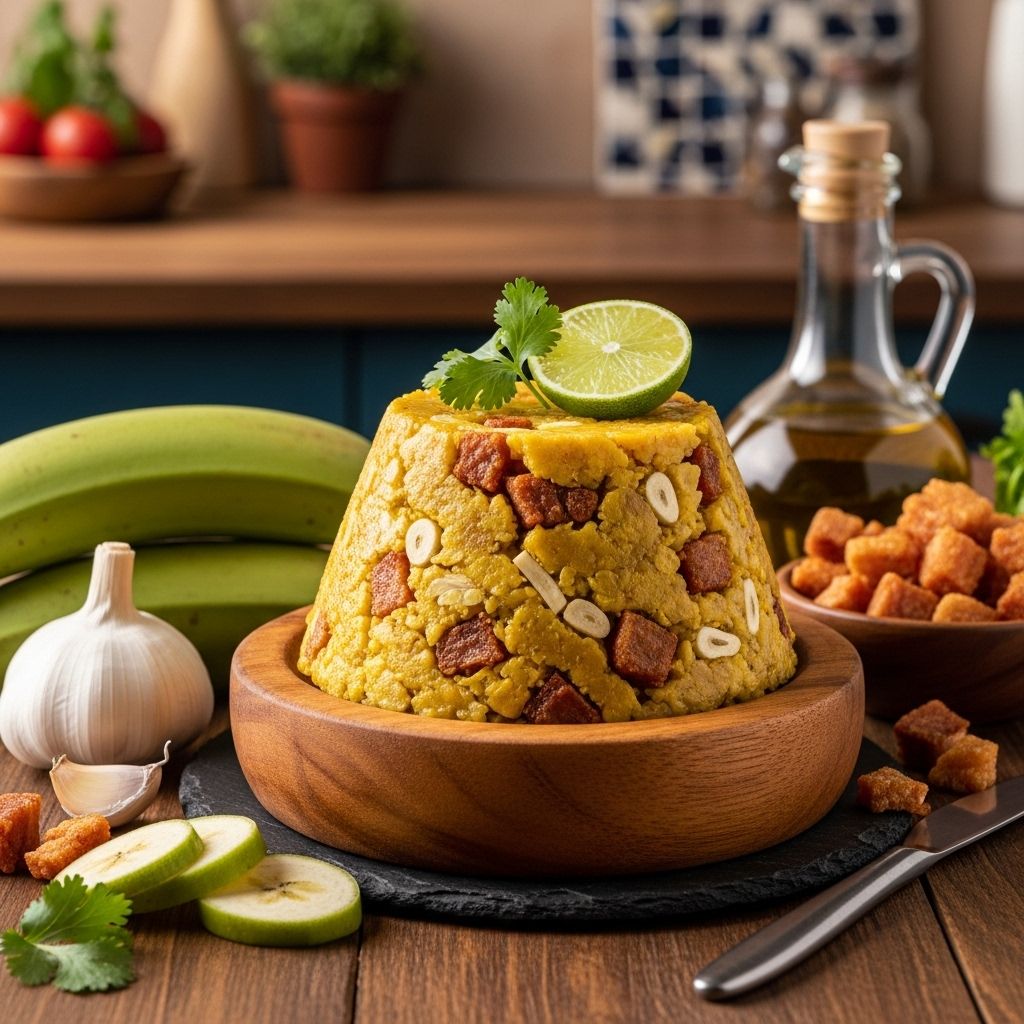Puerto Rican Mofongo Recipe: Authentic Step-By-Step Guide
Master the art of making traditional mofongo with crispy plantains, garlic, and pork rinds

Image: HearthJunction Design Team
Authentic Puerto Rican Mofongo: A Flavorful Plantain Delight
Mofongo is a beloved Puerto Rican dish that showcases the rich culinary heritage of the island. This traditional recipe features crispy fried green plantains mashed with garlic, olive oil, and pork rinds (or bacon) to create a savory, textured dish that’s both satisfying and full of authentic flavor. Whether you’re familiar with Caribbean cuisine or exploring it for the first time, mofongo offers a delicious introduction to Puerto Rican cooking traditions that have been passed down through generations.
What is Mofongo?
Mofongo is one of the most iconic dishes in Puerto Rican cuisine, with roots tracing back to West African fufu, a starchy side dish made from boiled and pounded yams or plantains. When African culinary techniques met Caribbean ingredients, mofongo was born. The dish consists of green plantains that are fried until crispy, then mashed together with garlic, olive oil, and chicharrones (pork rinds) or bacon to form a flavorful, textured mound that can be served as a side dish or as a main course when topped with meat, seafood, or vegetables.
The beauty of mofongo lies in its contrasting textures and flavors—crispy exterior, soft interior, savory garlic notes, and the rich umami from the pork elements. Traditionally, mofongo is prepared using a wooden mortar and pestle called a pilón, which helps achieve the perfect consistency while preserving some chunks of plantain for textural interest.
Ingredients for Traditional Mofongo
The beauty of mofongo lies in its simplicity. You’ll need only a handful of ingredients to create this flavorful dish:
- 2 green plantains, peeled and cut into 1-inch pieces
- 3 cups canola oil for frying
- 3 cloves garlic, minced or crushed
- 3 tablespoons olive oil
- 1/4 cup crushed fried pork skins (chicharrones) or cooked bacon
- Salt to taste
Kitchen Equipment You’ll Need
Before diving into the preparation, gather these essential tools:
- Deep fryer or large, deep skillet for frying plantains
- Mortar and pestle (pilón) – traditional and preferred, but not essential
- Slotted spoon for removing fried plantains
- Paper towels for draining excess oil
- Small bowl for mixing garlic and olive oil
- Serving dishes
Step-by-Step Preparation
Preparing the Plantains
The foundation of any good mofongo starts with properly prepared plantains:
- Select firm, green plantains – avoid any that show signs of yellowing as they will be too sweet for traditional mofongo.
- Cut off both ends of each plantain.
- Make shallow cuts along the ridges of the plantain and peel away the thick skin.
- Cut the peeled plantains into 1-inch thick rounds.
Frying Process
Achieving the perfect crispy texture requires attention to the frying process:
- Heat canola oil in a deep fryer or large skillet to 350°F (175°C).
- Carefully add the plantain pieces to the hot oil, working in batches to avoid overcrowding.
- Fry until the plantains turn a golden color and are crispy on the outside but still slightly soft inside, approximately 4-5 minutes.
- Remove with a slotted spoon and drain on paper towels to remove excess oil.
Creating the Garlic Mixture
The aromatic garlic mixture gives mofongo its distinctive flavor:
- In a small bowl, combine minced garlic with olive oil.
- Mash the mixture slightly to release the garlic’s flavors.
- Let it sit while you prepare the other components to allow the flavors to meld.
Mashing and Molding
This is where the magic happens – transforming simple ingredients into cohesive mofongo:
- While the plantains are still warm, place a portion into a mortar (pilón) or a sturdy bowl.
- Add a portion of the garlic-oil mixture and a portion of the crushed pork rinds or bacon.
- Using a pestle or potato masher, begin mashing the ingredients together. The goal is to create a cohesive mixture while still maintaining some texture – you don’t want a completely smooth paste.
- Season with salt to taste and continue mashing until well combined.
- Shape the mofongo into a dome or ball by pressing it firmly against the sides of the mortar.
- Carefully turn the mortar upside down onto a serving plate to unmold the mofongo.
- Repeat with remaining ingredients to create individual servings.
Serving Suggestions and Variations
Traditional Serving Styles
In Puerto Rico, mofongo is served in various ways, each offering a unique dining experience:
- Plain Mofongo: Served as a side dish alongside main courses.
- Mofongo Relleno: Stuffed mofongo filled with seafood, chicken, beef, or vegetables.
- With Broth: Served with a small cup of chicken broth on the side, which can be poured over the mofongo or used for dipping.
Popular Accompaniments
Enhance your mofongo experience with these complementary elements:
- Grilled shrimp or fish
- Roasted chicken
- Stewed beef
- Crispy fried pork (pernil)
- Avocado slices
- Fresh lime wedges
Regional and Modern Variations
While traditional mofongo has its charms, there are numerous variations worth exploring:
- Trifongo: A combination of green plantains, sweet plantains, and yuca, offering a more complex flavor profile.
- Vegan Mofongo: Omits pork rinds and may include additional vegetables or plant-based proteins.
- Seafood Mofongo: Incorporates shrimp, lobster, or fish directly into the mashed plantain mixture.
- Mofongo Bites: Smaller, appetizer-sized portions perfect for sharing.
Tips for Perfect Mofongo
Achieve restaurant-quality results with these professional insights:
- Choose the Right Plantains: Select plantains that are completely green for the authentic starchy texture. Yellow or spotted plantains will yield a sweeter result that’s not traditional for mofongo.
- Fry at the Proper Temperature: Maintain oil temperature around 350°F (175°C) for optimal crispiness without absorbing too much oil.
- Work in Batches: For the best texture, prepare individual portions of mofongo rather than one large batch.
- Serve Immediately: Mofongo is prone to drying out quickly, so serve it right after preparation for the best experience.
- Keep It Moist: If the mixture seems too dry while mashing, add a small amount of chicken broth or additional olive oil.
Nutritional Information and Dietary Considerations
While mofongo is delicious, it’s also important to understand its nutritional profile:
| Nutrient | Amount per Serving |
|---|---|
| Calories | Approximately 350-450 |
| Carbohydrates | 50-60g |
| Protein | 5-10g |
| Fat | 15-25g |
| Fiber | 4-6g |
Dietary Adaptations
Mofongo can be adapted to suit various dietary needs:
- Gluten-Free: Traditional mofongo is naturally gluten-free, making it suitable for those with celiac disease or gluten sensitivities.
- Vegan/Vegetarian: Substitute pork rinds with roasted garlic, additional herbs, or nutritional yeast for umami flavor.
- Lower-Fat Version: Bake the plantains instead of frying and use less oil in the garlic mixture.
The Cultural Significance of Mofongo
Beyond its delicious taste, mofongo holds deep cultural significance in Puerto Rico. This dish represents the blending of African, Spanish, and Taíno influences that characterize Puerto Rican cuisine. The technique of mashing starchy vegetables in a mortar and pestle was brought by African slaves, while the garlic and olive oil reflect Spanish culinary traditions.
In Puerto Rico, mofongo is more than just food—it’s a symbol of resilience, creativity, and cultural pride. Family recipes are treasured and passed down through generations, with each family often having their own special twist on the basic recipe. When Puerto Ricans living abroad prepare mofongo, it serves as a powerful connection to their heritage and homeland.
Common Mistakes to Avoid
Even experienced cooks can encounter challenges when preparing mofongo for the first time. Here are some pitfalls to avoid:
- Using Ripe Plantains: Yellow or black plantains will result in a sweet mofongo that lacks the traditional savory profile.
- Overmashing: Aim for a cohesive yet textured consistency—not a smooth paste.
- Letting It Cool: Mofongo is best served immediately after preparation while still warm.
- Insufficient Seasoning: Don’t be shy with the garlic and salt—mofongo should be boldly flavored.
- Using Low-Quality Pork Rinds: Fresh, crispy chicharrones make a significant difference in the final flavor.
Storage and Reheating
While mofongo is ideally enjoyed fresh, sometimes you may have leftovers:
- Storage: Place cooled mofongo in an airtight container and refrigerate for up to 2 days.
- Reheating: The best method is to break the mofongo into pieces, sprinkle with a little chicken broth or water, cover, and microwave until heated through. Alternatively, reheat in a skillet with a little oil.
- Freezing: Not recommended as the texture significantly deteriorates.
Frequently Asked Questions (FAQs)
Q: Can I make mofongo without a traditional pilón (mortar and pestle)?
A: Yes, while a pilón is traditional and produces the best texture, you can use a potato masher in a sturdy bowl. Some people also use a food processor with brief pulses, though this risks creating too smooth a texture.
Q: Are there any shortcuts to making mofongo?
A: Traditional mofongo doesn’t have many shortcuts, but you could use store-bought fried plantain chips in a pinch (though the texture won’t be the same). For a quicker version, some cooks use tostones (twice-fried plantain slices) from Latin grocery stores.
Q: Can mofongo be prepared in advance for a party?
A: Mofongo is best prepared fresh and served immediately. If you must prepare components in advance, you can fry the plantains earlier in the day and then reheat them briefly before mashing with the other ingredients just before serving.
Q: What’s the difference between mofongo and tostones?
A: While both dishes use green plantains, tostones are plantain slices that are fried, smashed flat, and fried again to create crispy discs. Mofongo takes fried plantain pieces and mashes them with garlic, oil, and pork rinds to create a textured, savory mound.
Q: Is mofongo spicy?
A: Traditional mofongo is not spicy. Its flavor profile is savory and garlicky rather than hot. However, you can add hot sauce or spicy toppings if you prefer a kick of heat.
Conclusion
Mofongo represents the heart and soul of Puerto Rican cuisine—a dish that transforms humble ingredients into something truly special. The process of making mofongo, from selecting the perfect green plantains to the rhythmic mashing in the pilón, connects modern cooks with centuries of culinary tradition.
Whether you’re preparing mofongo as part of exploring your own Puerto Rican heritage or simply broadening your culinary horizons, this dish offers a delicious entry point into Caribbean cooking. The contrast of textures, the bold garlic flavor, and the satisfying heartiness make mofongo a dish worth mastering.
So gather your ingredients, embrace the process, and prepare to delight in this authentic taste of Puerto Rico. ¡Buen provecho!
References
Read full bio of Srija Burman












